Prepare a Slice of Your Yard For a Pollinator Garden
More than 85% of North American households have an outdoor living space. This Midwestern gardener swapped parts of her lawn for native plants that feed pollinators and wildlife.
Prepare a Slice of Your Yard For a Pollinator Garden
More than 85% of North American households have an outdoor living space. This Midwestern gardener swapped parts of her lawn for native plants that feed pollinators and wildlife.
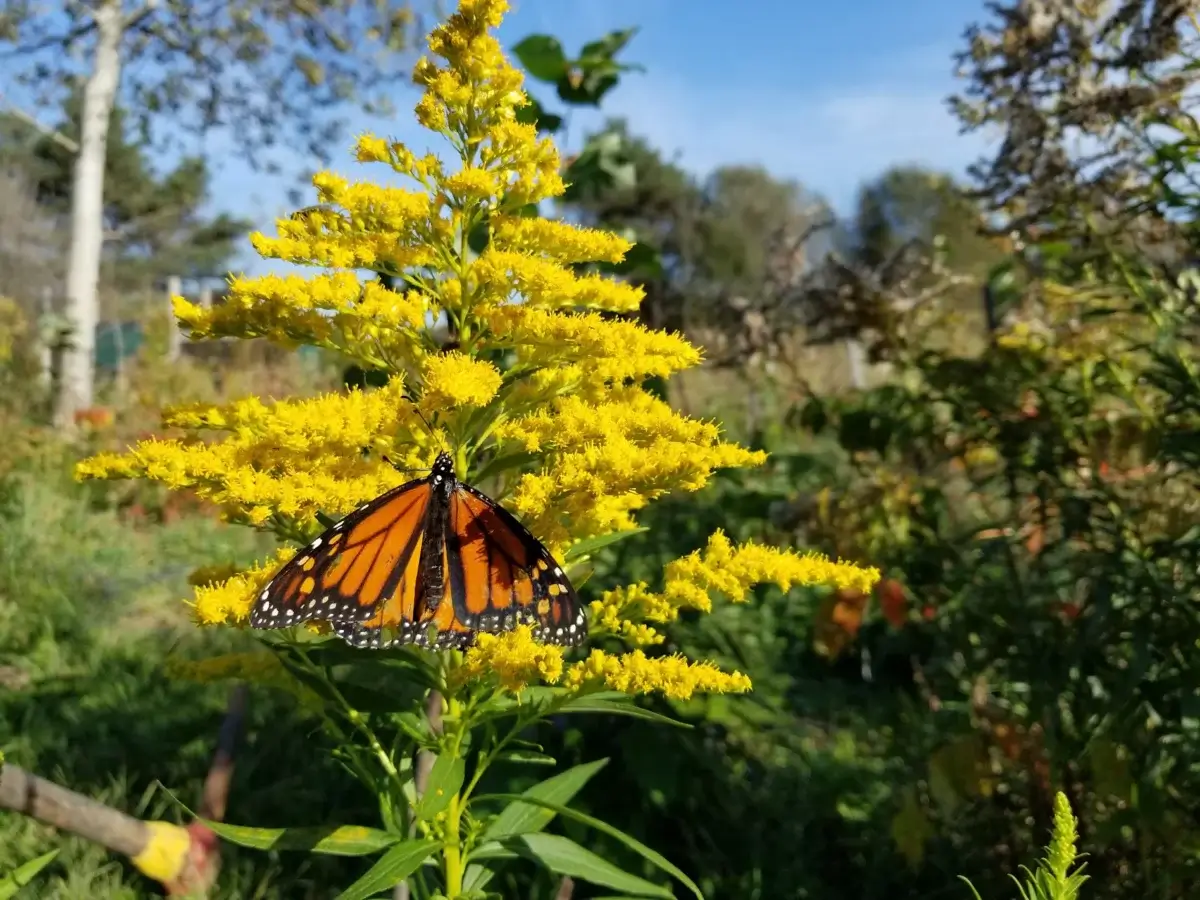
A monarch lands on a flowering goldenrod blossom. from David O'Donnell
Last winter’s annual count of eastern monarch butterflies was the second-lowest on record. Many of the roughly 4,000 wild bee species native to North America are also imperiled. Replacement of habitat with agricultural land, lawns and urban development poses one of the main threats to these pollinators and other beneficial insects such as lady beetles that eat insect pests. Many flowering plants and trees, including an estimated 35 percent of the world’s food crops, rely on pollinators to reproduce.
As a gardener in the Midwest, I am surrounded by agricultural farmland and housing developments that have largely replaced the tallgrass prairie that provided habitat for pollinators and other wildlife prior to European settlement. I decided to devote some of my outside space to these essential creatures. But before I started, I needed to figure out which plants would thrive in my yard’s environment.
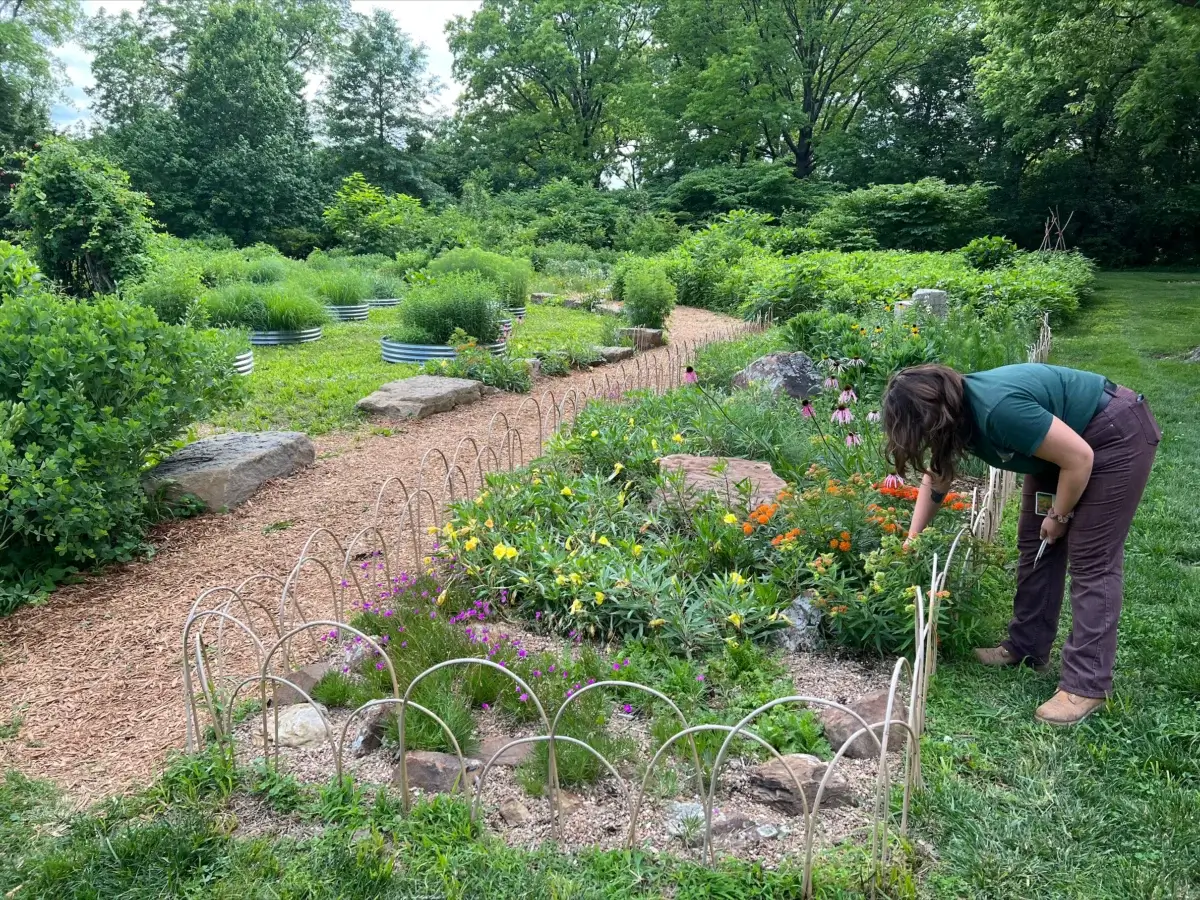
Choosing plants native to the region is best as they are well suited to the local soil and climate. Pollinators have adapted to native plants; they have co-existed for hundreds of years. There are plenty of native plants to choose from that are attractive and provide pollinator habitat.
“Be a planner, not a plopper,” says Cydney Ross, outdoor education program manager for Deep Roots KC, a Kansas City, Missouri nonprofit.
Ross suggests taking photos at different times of the day for at least one season to find out how many hours of sunlight each part of your yard receives. Pollinators forage in areas with six to eight hours of full sunlight a day.
I planted patches of pollinator habitat in my yards in Nebraska and Iowa, and for each location, I learned to pay attention to the hours of sunlight available after the trees have fully leafed out. When there are mature trees nearby, the hours of sunlight available can change quite a bit from early May to July.
Soil and moisture are other considerations. Ken Parker, a western New York-based native plant grower and consultant with Native Plant Guy Consulting, says fancy soil tests are unnecessary. Simply identify the type of soil that you have—for example, is it clay, loam or sandy? To determine soil type, I place a ball of wet soil similar to the consistency of Play-Doh in my hand. Sandy soil is gritty and hard to form a ball, whereas clay is much stickier. Loam tends to be a mix of the two and feels silky in your hand and forms a loose ball.
Next, I observed where water pooled in my yard to identify areas that are especially wet. I mostly worked with sandy and loam soil and have noticed the plants that thrive in my area can change depending on soil conditions. Cream wild indigo and prairie dropseed are among the species that have grown better in my sandy soils, while a wide variety of plant species such as New England aster, wild bergamot and sideoats grama (a short prairie grass) grow well in loam soil.
When planting native plants, it’s unnecessary to add amendments to the soil such as peat moss and fertilizer. These plants are hardy and do not need these supplements, which will just encourage weeds.
Once I understood sunlight, soil and moisture conditions, I was able to pick plant species that fit my yard’s environment.
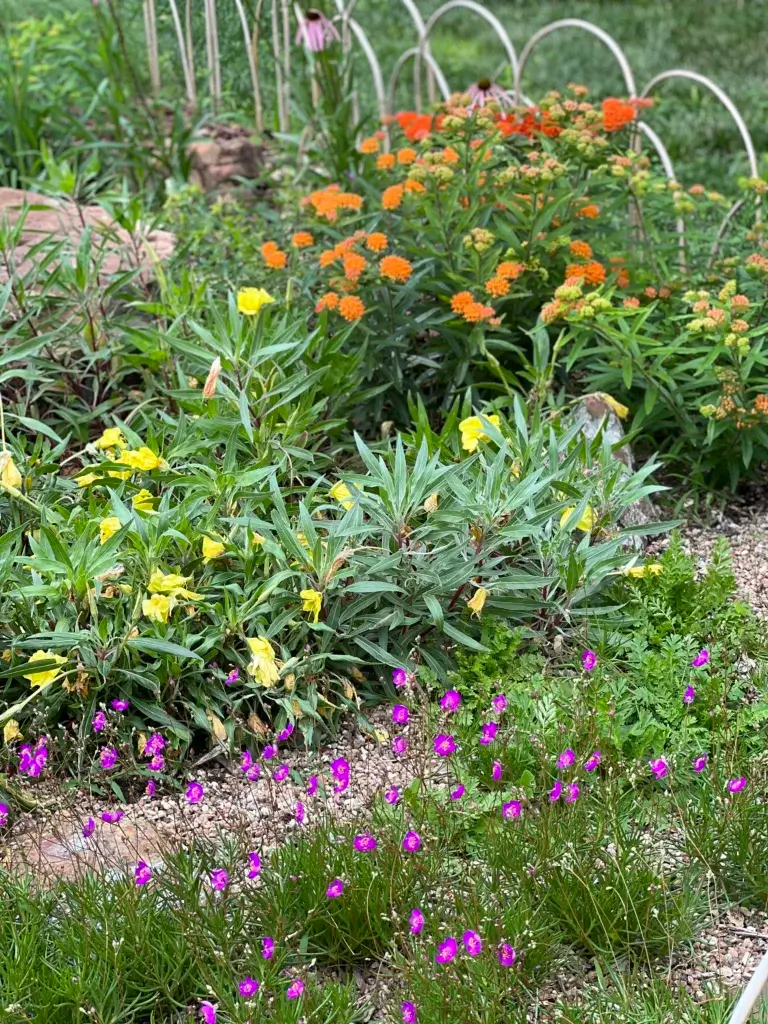
State native plant societies are a good starting point for finding a local native plant organization and nursery that specializes in growing natives. These organizations and nurseries are good resources for learning about the habitat requirements of different species and how to plant them. I have ordered most of my native plants from regional nurseries in flats through the mail, and they have arrived in good condition.
Established plants are advised for starting smaller pollinator gardens (less than roughly 250 to 500 square feet); they are more expensive than seed, but they will establish more quickly, reducing time spent weeding.
I planted my first pollinator garden with a pre-made native grass and wildflower seed mix when I was in my 20s and a graduate student with a flexible schedule. I enjoyed spending time on my hands and knees with a plant ID guide getting to know which young seedlings were something I had planted and which were weeds that needed to be pulled. However, as I got older and wanted to spend less time weeding, I switched to planting small plants. I also like getting to mature plants quicker when starting with plants.
Parker recommends choosing an equal number of wildflower species that bloom in the early spring, summer and fall—he likes four flowering species during each season. “The more species you have, the more your habitat becomes a buffet” for different types of adult pollinators and larvae, which will also attract birds, he says.
My current garden has patches of pollinator habitat with 20 native plant species; the wildflowers bloom from May through early October. In my sunny, steep front yard, I planted a five-foot-wide strip with taller species such as stiff goldenrod, wild bergamot and common milkweed in the back and the shorter prairie dropseed grass and smooth aster in the front. Monarch larvae feed on milkweed, but adult monarchs and many other pollinators feed on the nectar and pollen of a variety of flowering species––in the fall, the blooms of the stiff dropseed are alive with activity from small bees to butterflies.
Near my vegetable garden there’s prairie alumroot, sweet coneflower, Joe Pye weed and foxglove beardtongue. The beardtongue is among my favorite plants. Its tubular white flowers are especially popular with bumblebees and hummingbirds.
Grasses and sedges (grass-like plants with fine leaves) provide texture, and their dense roots will occupy space, reducing weed establishment. I like to include clump-forming grasses such as little bluestem that are host plants for the larvae of skippers, a type of butterfly. I have also started planting more sedges around my flowering plants since they green up early in the growing season and deter rabbits from feeding on other plants. As garden designer Benjamin Vogt with Monarch Gardens in Lincoln, Nebraska, says, “Sedges are wildflower bodyguards.”
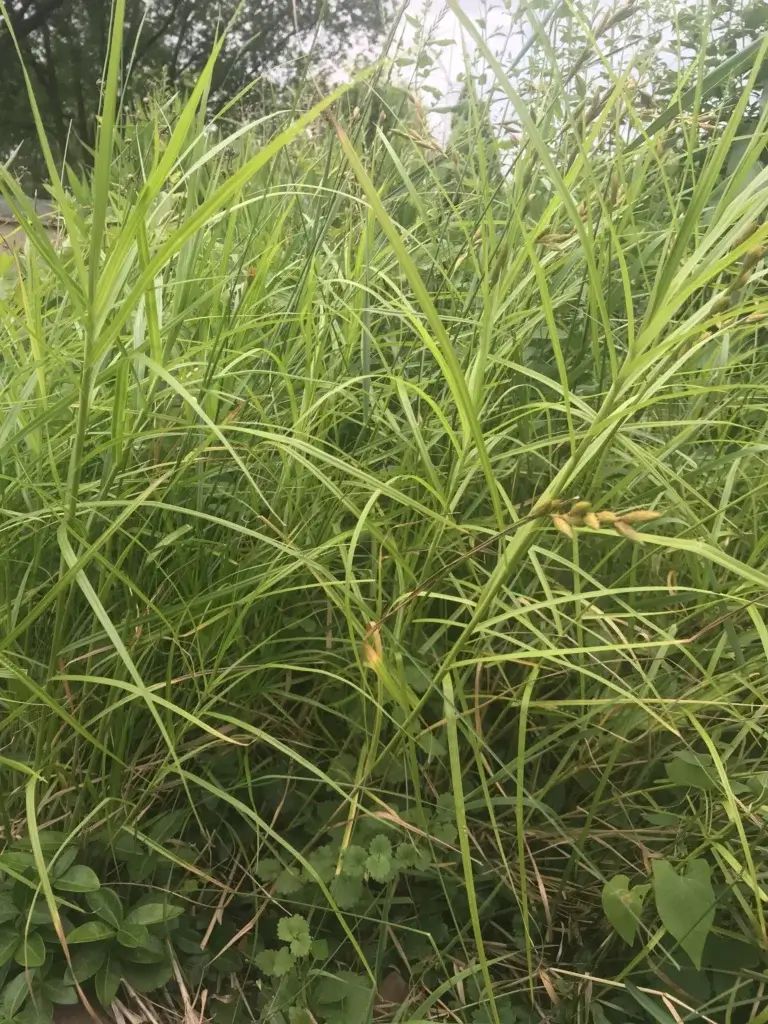
Before the actual planting could begin, the area needs to be prepared by reducing weeds and grasses. This can be very labor intensive, but there are several methods that garden designers recommend––my favorite is sheet mulching for my gardens.
Sheet mulching: Mow or weed whack your lawn and weeds short, then put layers of cardboard or newspaper down for several weeks; add mulch on top to keep the layers in place. Poke holes into the layers and insert your plants.
Solarization: During the summer, staple clear plastic tarp into the lawn to use heat to kill the grass, weeds and weed seeds. Leave in place for two to three weeks in dry climates to several weeks in wetter climates until the vegetation is dead. Remove the plastic before adding your plants in the fall.
Herbicide: This is the most controversial method. Glyphosate is very effective at killing grass and weeds, but most pollinator experts avoid using it because of potential effects on human health, the environment and the pollinators they are trying to attract.
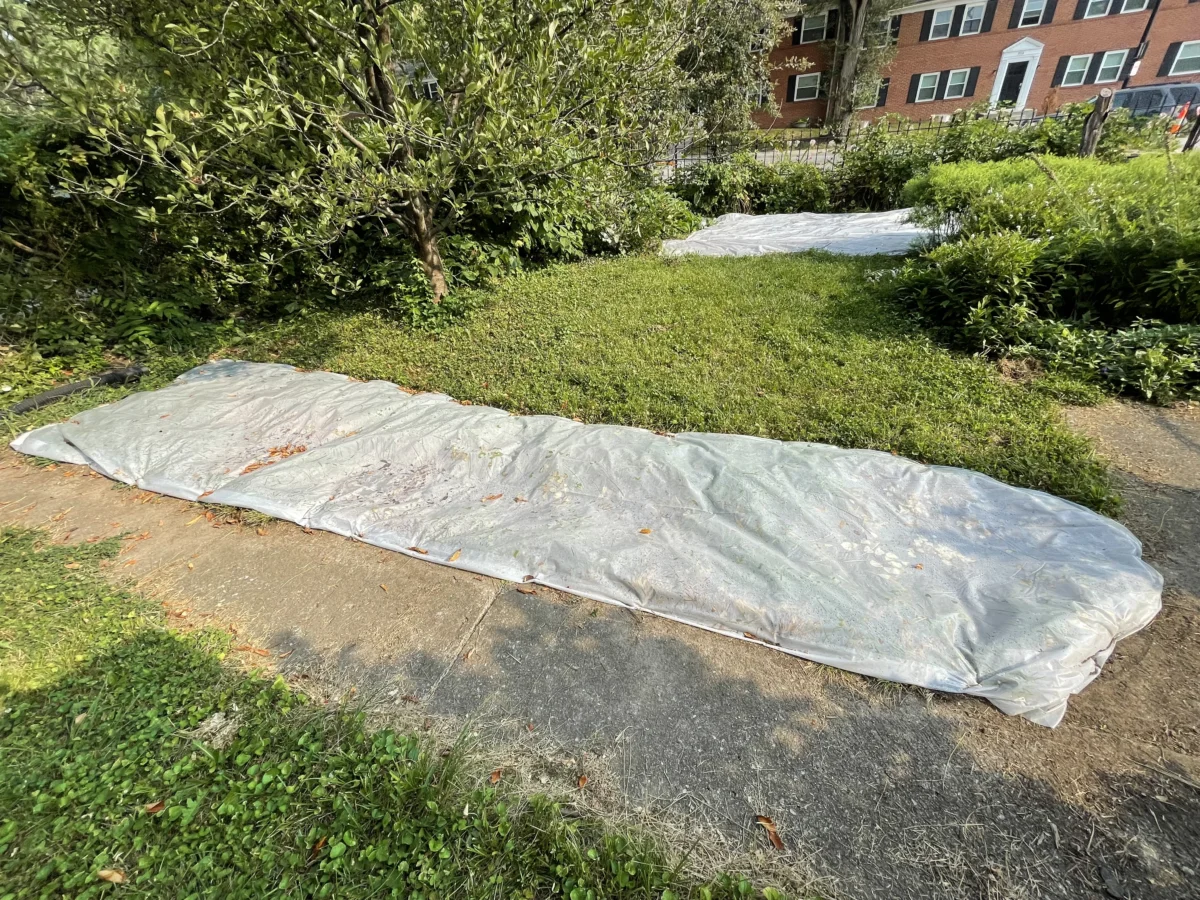
Each of my gardens were planted over time. Ross suggests that planning in stages, even when converting large portions of a lawn to a pollinator habitat, keeps the project affordable and manageable. And starting with a small area allows you to confirm which species establish well and the weed control methods that work well before scaling up. Including native ground-spreading covers to serve as a living mulch can also reduce weeds.
In the first year, plants should put their energy into growing roots. To support their growth and to reduce weed competition, I add a one- to two-inch layer of mulch after planting and regularly water for the first two weeks if there isn’t regular rainfall.
Over the second and third year, allowing the mulch to break down, trimming weeds and giving plants space to spread will allow the natives to replace the mulch. “They will find where they’re happiest,” says Parker.
The right garden preparation has paid dividends in creating an hospitable habitat lively with pollinators and other wildlife. My gourd plants are plentiful each year thanks to natural insect pollination. I watch birds feed on caterpillars in the spring and summer and the seed heads of sweet black-eyed Susan and Joe Pye weed in the fall and winter. It’s a small step to make my yard a more welcoming place for these creatures, but, selfishly, the pleasure I derive in seeing a butterfly float by on a summer breeze or bumblebees visit my flowers is immeasurable.
Follow us

This work is licensed under a Creative Commons Attribution-NoDerivatives 4.0 International License.
Want to republish a Modern Farmer story?
We are happy for Modern Farmer stories to be shared, and encourage you to republish our articles for your audience. When doing so, we ask that you follow these guidelines:
Please credit us and our writers
For the author byline, please use “Author Name, Modern Farmer.” At the top of our stories, if on the web, please include this text and link: “This story was originally published by Modern Farmer.”
Please make sure to include a link back to either our home page or the article URL.
At the bottom of the story, please include the following text:
“Modern Farmer is a nonprofit initiative dedicated to raising awareness and catalyzing action at the intersection of food, agriculture, and society. Read more at <link>Modern Farmer</link>.”
Use our widget
We’d like to be able to track our stories, so we ask that if you republish our content, you do so using our widget (located on the left hand side of the article). The HTML code has a built-in tracker that tells us the data and domain where the story was published, as well as view counts.
Check the image requirements
It’s your responsibility to confirm you're licensed to republish images in our articles. Some images, such as those from commercial providers, don't allow their images to be republished without permission or payment. Copyright terms are generally listed in the image caption and attribution. You are welcome to omit our images or substitute with your own. Charts and interactive graphics follow the same rules.
Don’t change too much. Or, ask us first.
Articles must be republished in their entirety. It’s okay to change references to time (“today” to “yesterday”) or location (“Iowa City, IA” to “here”). But please keep everything else the same.
If you feel strongly that a more material edit needs to be made, get in touch with us at [email protected]. We’re happy to discuss it with the original author, but we must have prior approval for changes before publication.
Special cases
Extracts. You may run the first few lines or paragraphs of the article and then say: “Read the full article at Modern Farmer” with a link back to the original article.
Quotes. You may quote authors provided you include a link back to the article URL.
Translations. These require writer approval. To inquire about translation of a Modern Farmer article, contact us at [email protected]
Signed consent / copyright release forms. These are not required, provided you are following these guidelines.
Print. Articles can be republished in print under these same rules, with the exception that you do not need to include the links.
Tag us
When sharing the story on social media, please tag us using the following: - Twitter (@ModFarm) - Facebook (@ModernFarmerMedia) - Instagram (@modfarm)
Use our content respectfully
Modern Farmer is a nonprofit and as such we share our content for free and in good faith in order to reach new audiences. Respectfully,
No selling ads against our stories. It’s okay to put our stories on pages with ads.
Don’t republish our material wholesale, or automatically; you need to select stories to be republished individually.
You have no rights to sell, license, syndicate, or otherwise represent yourself as the authorized owner of our material to any third parties. This means that you cannot actively publish or submit our work for syndication to third party platforms or apps like Apple News or Google News. We understand that publishers cannot fully control when certain third parties automatically summarize or crawl content from publishers’ own sites.
Keep in touch
We want to hear from you if you love Modern Farmer content, have a collaboration idea, or anything else to share. As a nonprofit outlet, we work in service of our community and are always open to comments, feedback, and ideas. Contact us at [email protected].by Kristine Nemec, Modern Farmer
July 11, 2024
Modern Farmer Weekly
Solutions Hub
Innovations, ideas and inspiration. Actionable solutions for a resilient food system.
ExploreExplore other topics
Share With Us
We want to hear from Modern Farmer readers who have thoughtful commentary, actionable solutions, or helpful ideas to share.
SubmitNecessary cookies are absolutely essential for the website to function properly. This category only includes cookies that ensures basic functionalities and security features of the website. These cookies do not store any personal information.
Any cookies that may not be particularly necessary for the website to function and are used specifically to collect user personal data via analytics, ads, other embedded contents are termed as non-necessary cookies.
Grew up on afarm, and, takewhat I have learned and apply that knowledge today. It has been a shame today that everyone has gone to corporate America. Forgetting about what has got them there and we are the bases for keeping America going.